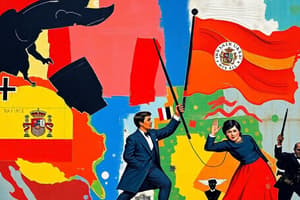Podcast
Questions and Answers
What was the Spanish-American War?
What was the Spanish-American War?
- A conflict between Spain and the U.S. fought in the Philippines and Cuba (correct)
- A trade agreement between the U.S. and Spain
- A diplomatic discussion between the U.S. and Spain
- An internal conflict within Spain
Which factors led to the Spanish-American War? (Select all that apply)
Which factors led to the Spanish-American War? (Select all that apply)
- Yellow Journalism (correct)
- American imperialism (correct)
- Spain's mismanagement of its colonies (correct)
- Opium Wars
What was the primary reason for American sympathy towards the Cuban rebels?
What was the primary reason for American sympathy towards the Cuban rebels?
Cuba had been rebelling against Spain for 30 years.
America wanted war with Spain.
America wanted war with Spain.
What is Yellow Journalism?
What is Yellow Journalism?
Who were the two prominent yellow journalists?
Who were the two prominent yellow journalists?
Who was De Lome?
Who was De Lome?
What did the De Lome letter say about President McKinley?
What did the De Lome letter say about President McKinley?
What event pushed America to declare war?
What event pushed America to declare war?
What was the purpose of sending the U.S.S. Maine to Cuba?
What was the purpose of sending the U.S.S. Maine to Cuba?
What happened when the U.S.S. Maine exploded?
What happened when the U.S.S. Maine exploded?
What was the war cry during the Spanish-American War?
What was the war cry during the Spanish-American War?
What assistance did the U.S. offer during the war?
What assistance did the U.S. offer during the war?
Who led the U.S. victory at the Battle of Manila Bay?
Who led the U.S. victory at the Battle of Manila Bay?
The Spanish fleet was destroyed during the war.
The Spanish fleet was destroyed during the war.
Who was Theodore Roosevelt?
Who was Theodore Roosevelt?
What were the Rough Riders?
What were the Rough Riders?
What were Buffalo Soldiers?
What were Buffalo Soldiers?
What was the significance of the Battle of San Juan Hill?
What was the significance of the Battle of San Juan Hill?
Who became famous after the Battle of San Juan Hill?
Who became famous after the Battle of San Juan Hill?
What were the results of the Spanish-American War? (Select all that apply)
What were the results of the Spanish-American War? (Select all that apply)
What was the Treaty of Paris?
What was the Treaty of Paris?
How many U.S. casualties were there in the war?
How many U.S. casualties were there in the war?
What were the territorial gains from the Spanish-American War?
What were the territorial gains from the Spanish-American War?
If the Spanish-American War hadn't happened, what wouldn't have occurred?
If the Spanish-American War hadn't happened, what wouldn't have occurred?
Flashcards are hidden until you start studying
Study Notes
Spanish-American War Overview
- Conflict between Spain and the U.S. occurred in 1898, primarily in the Philippines and Cuba.
- Known as "the splendid little war" due to its brief duration and significant outcomes.
Causes of the War
- American imperialism fueled desires for territorial expansion.
- Yellow journalism played a crucial role by sensationalizing news of the Cuban Revolution to attract readers.
- Spain's mismanagement of its colonies, particularly in Cuba and the Philippines, led to escalating tensions.
- Social Darwinism influenced beliefs that the U.S. military needed to demonstrate its superiority.
Key Events and Players
- Long-standing unrest in Cuba, with continuous rebellion against Spanish rule for 30 years, garnered American sympathy.
- Growing sentiment in the U.S. for a war against Spain.
- The De Lome letter criticized President McKinley and was published, causing public outrage.
- The explosion of the U.S.S. Maine in Havana harbor killed 260 men, leading to the rallying cry, "Remember the Maine."
War Progression
- The U.S. intervened in the Philippines during the war, offering military assistance.
- The Battle of Manila Bay marked the first major engagement, resulting in a decisive victory for U.S. forces led by Commodore George Dewey.
- Advance of the U.S. fleet was aided by superior steel ships compared to Spain's wooden vessels.
Key Military Figures
- Theodore Roosevelt resigned as Secretary of the Navy to join the Rough Riders, a volunteer cavalry unit.
- The Rough Riders, along with Buffalo Soldiers, played pivotal roles in battles, particularly at San Juan Hill, which was critical for U.S. positioning.
Outcomes and Consequences
- The U.S. emerged victorious, leading to the Treaty of Paris, which ended the war.
- The Treaty granted the U.S. Guam and Puerto Rico, while also addressing the Philippines, for which the U.S. paid Spain $20 million.
- Approximately 5,400 American soldiers died, with 5,000 of those from malaria, highlighting the war's health challenges.
- U.S. territorial gains post-war bolstered its economic, political, and military standing globally.
- Largely affected international relations and policy, influencing events such as the Boxer Rebellion and the Open Door Policy in China.
Studying That Suits You
Use AI to generate personalized quizzes and flashcards to suit your learning preferences.




